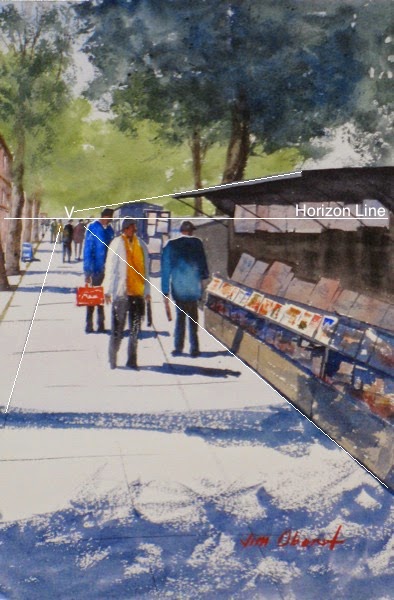Before we dive into perspective, it's very important to understand the horizon line, covered in Artist Tip #30. I suggest you review that post before proceeding here.
Perspective is the art of representing a 3-dimensional scene on a 2-dimensional surface so as to give the correct impression of the objects' relative sizes and positions when viewed from a particular point. There are 3 major conventions of perspective - designated as 0-point, 1-point and 2-point perspective - and these refer to the behavior on the painting surface of lines which are parallel in reality. For simplicity, we'll consider only lines that are parallel to each other and to the horizontal surface. All horizontal lines terminate in a vanishing point on the horizon line. As defined in Artist Tip #30, the horizon line is the distant horizontal line at your eye level as you're looking at the scene.
In 1-point perspective, parallel horizontal lines in the picture plane all converge on a single point on the horizon line called the vanishing point, usually within the painting frame. This happens when we look at a scene where we can only see one side of the included buildings, roads, etc. Here is an example - Seine-Side Booksellers - where the buildings on the right and the tree line on the left "hem us in" between them:
 Here the single vanishing point is approximately at point "V", and is on the horizon line. Note that often a painting looks more "relaxed" and less mechanical if a small vanishing "area" is chosen rather than a strict point.
Here the single vanishing point is approximately at point "V", and is on the horizon line. Note that often a painting looks more "relaxed" and less mechanical if a small vanishing "area" is chosen rather than a strict point.Also note where the heads of the adults are - all are on or near the horizon line, regardless of how close or far they are from the viewer, because they and the viewer are all standing on the same level sidewalk. The position of the feet determines how close the figures look; the position of their heads indicates how tall they are. This is very important information to be aware of if you are adding figures or moving them around in your scenes. If the sidewalk cracks and the book stands were not parallel to each other, they would not point to the same vanishing point.
Here is one other example of a single vanishing point. But in Spruce Head Wharf we can only see buildings on the left side, and the single vanishing point is beyond the edge of the painting:
Here, note that the viewpoint is above the two figures, so their heads are lower than the horizon line. If the viewer were lower - say, on a boat in the water near the bottom of the painting, the heads would be above the horizon line.
In 2-point perspective, we see both sides of, for example, a building, and the horizontal parallel lines from the different sides have a different vanishing point. In the painting Gambrel Roof Barn, we see both sides of the barn, so there are two different vanishing points:
Both happen to be beyond the edges of the painting. If the viewpoint were closer to the barn, we would see more acute angles, and the vanishing points would move in toward the painting.
Now, if the viewer stands directly in front of a shape, like a building, and far enough away so that one side is perpendicular to him/her, and the other sides cannot be seen, perspective degenerates into entirely parallel lines, or 0-point perspective. In this case, the parallel lines in reality remain parallel in the painting, as in the painting Cheyenne Station:
This is by far the simplest type of perspective - no perspective at all! Lines that are parallel and horizontal in the "real world" stay that way in the painting.
I hope you've found this brief discussion of the basics of perspective useful. To cover perspective in depth would take an entire book, but what I've covered here will stand most realistic painters in good stead.
I hope you found this artist tip useful. If you'd like to get artist and art collector tips like this delivered directly to your inbox every few weeks, sign up for my fine art e-newsletter here! When you subscribe, you'll receive a 10% instant rebate valid for one month for any of my paintings.



